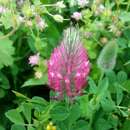fr
noms dans le fil d’Ariane


Mareotic sector, north Sinai, Mountainous southern Sinai.
Mediterranean region, west Asia.
Annual.
Trifolium purpureum one of the 300 species of the clover genus Trifolium (Fabaceae).It is native to fields, roadsides, and disturbed area in southern Europe from Portugal to Romania, the Crimea to Israel and to North Africa from Egypt to Morocco.The plant has also been recorded in northeast Massachusetts, around wool waste plants, where it evidently was introduced from Europe (Fletcher 1913). In NSW, Australia, T. purpureum has been developed as a pasture species because it produces green feed longer in the spring/summer than do other annuals and is tolerant of a variety of soil type and water logging, and it is grown for silage and hay in Europe as well as Australia.An annual, self-regenerating herbaceous plant, it grows upright, usually between 10 and 50 cm, sometimes up to a meter tall. It has long thin leaflets and a triangular, purple flower up to 8 cm (3 inches) long (Hacker et al. 2006; Wikipedia 2014).
Trifolium purpureum contains glycosides, phenols, Komorinim, flavonoids, and Silitzilitim mineral acids.It is commonly used in Arab folk medicine to treat diarrhea, menstrual irregularities, skin damage, cough, rubella, and for stress, nervousness and insomnia (Wikipedia 2014).
Trifolium purpureum ist eine Pflanzenart aus der Gattung Klee (Trifolium). Er wird in der Gattung in die Sektion Trifolium, Untersektion Angustifolia gestellt.
Trifolium purpureum ist eine einjährige, krautige Pflanze, die Wuchshöhen zwischen 10 und 50 Zentimeter erreicht. Die Sprossachse ist gestreift und verzweigt, oft stehen viele Stängel dicht nebeneinander. Sie ist fast immer aufrecht, selten aber auch aufsteigend.
Die unteren Laubblätter sind lang gestielt. Die Blattstiele werden nach oben hin aber beständig kürzer. Die Blätter sind dreifiedrig, die einzelnen Fiedern zwischen 1 und 6 Zentimeter lang und 0,1 bis 1 Zentimeter breit. Die Spreiten sind länglich lanzettlich oder linealisch. Der Blattrand ist haarig. Die Nebenblätter sind länglich lanzettlich und vielnervig. Sie sind 1 bis 1,5 Zentimeter lang. Der freie Teil ist pfriemlich. Zwischen den Blattrippen sind die Nebenblätter papierartig.
Die Blütenstände sitzen endständig auf den Stängeln oder Zweigen. Sie sind während der Anthese konisch bis eiförmig, verformen sich bei der Fruchtreife aber zum Zylindrischen hin.
Der Kelch ist bis zu 1 Zentimeter lang und angepresst behaart. Er ist im unteren Teil (etwa 3 Millimeter lang) röhrenförmig. Die Kelchzähne sind ungleich, die unteren nahezu doppelt so lang wie die oberen. Die Krone ragt zu einem Drittel aus dem Kelch heraus. Der obere Teil ist purpurn, der untere weißlich-violett.
In der Fruchtreife verschließt sich die Kelchröhre mit zwei behaarten Verdickungen. Die Kelchzähne stehen ab. Die Hülsenfrüchte sind häutchenartig, eiförmig mit ledriger Spitze. Die Samen sind gelblich bis orange-braun.
Die Chromosomenzahl ist 2n = 14.
Das Verbreitungsgebiet von Trifolium purpureum umfasst Südeuropa von Rumänien bis Portugal, die Krim bis Israel und Nordafrika von Ägypten bis Marokko. Daneben findet sich die Art auf den Azoren, den Kanaren und Madeira. Neophytische Vorkommen finden sich in Massachusetts im Osten der Vereinigten Staaten.
Trifolium purpureum wächst auf Äckern, an Wegrändern und unter Gebüschen. Die Art liebt steinigen, sandigen Boden.
Trifolium purpureum ist eine Pflanzenart aus der Gattung Klee (Trifolium). Er wird in der Gattung in die Sektion Trifolium, Untersektion Angustifolia gestellt.
Trifolium purpureum là một loài thực vật có hoa trong họ Đậu. Loài này được Loisel. miêu tả khoa học đầu tiên.[1]
Trifolium purpureum là một loài thực vật có hoa trong họ Đậu. Loài này được Loisel. miêu tả khoa học đầu tiên.